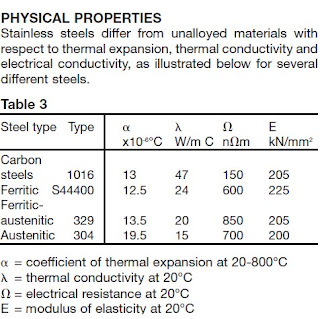The differences have to be taken into consideration by both designer and welder. The high thermal expansionand low thermal conductivity of the austenitic steels lead to higher shrinkage stresses in the weld thanwhen carbon and ferritic steels are used. Thin sections of austenitic steels may therefore be deformed when an abnormally high heat input is used
These steels are mainly used in wet environments. Withincreasing chromium and molybdenum contents, the steels become increasingly resistant to aggressive solutions. The higher nickel content reduces the risk of stress corrosion cracking. Austenitic steels are more or less resistant to general corrosion, crevice corrosion
and pitting, depending on the quantity of alloying elements.
Resistance to pitting and crevice corrosion is very important if the steel is to be used in chloride-containing environments. Resistance to pitting and crevice corrosion increases with increasing contents of chromium, molybdenum and nitrogen.

Leave a Reply